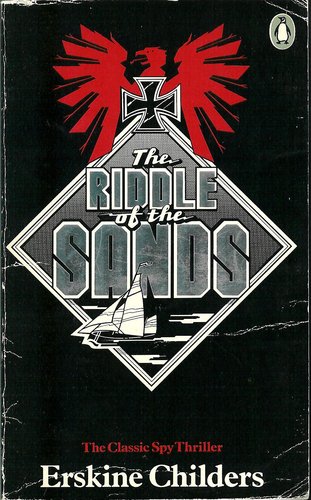 Home->Reviews->The Riddle of the Sands
Home->Reviews->The Riddle of the Sands
Reviewed by Paul M. Clayton
Considered to be the first book of the spy thriller genre, one might ask what it is doing in a sailing collection. In fact, the first half of the book is one of the finest fictional accounts of small boat sailing that has ever been written. It opens with the narrator stuck in London for the summer, a very junior grade member of the diplomatic office, feeling sorry for himself for having to be at work rather than at someone's country house, shooting during the day, flirting with the society girls at night. By the time he gets his turn at vacation, fall is approaching and the gentry are in process of closing their country houses. It is then that he receives a letter from a college chum, inviting him to come to the Baltic for some yachting and duck hunting.
Arriving at Flensburg, the narrator expects to find a gleaming yacht, with a boatswain to ferry him out in a tender and pipe him aboard, but in fact finds his friend Davies with a tiny rowboat at a slick, moss-covered dock. They row out to the "yacht", and here we can follow the description in the book:
"She seemed very small (in point of fact she was seven tons), something over thirty feet in length and nine in beam, a size very suitable to week-ends in the Solent, for such as liked that sort of thing; but that she should have come from Dover to the Baltic suggested a world of physical endeavour of which I had never dreamed. I passed to the aesthetic side. Smartness and beauty were essential to yachts, in my mind, but with the best resolves to be pleased I found little encouragement here. The hull seemed too low, and the mainmast too high; the cabin roof looked clumsy, and the skylights saddened the eye with dull iron and plebeian graining. What brass there was, on the tiller-head and elsewhere, was tarnished with sickly green. The decks had none of that creamy purity which Cowes expects, but were rough and grey, and showed tarry exhalations round the seams and rusty stains near the bows. The ropes and rigging were in mourning when contrasted with the delicate buff manilla so satisfying to the artistic eye as seen against the blue of a June sky at Southsea. Nor was the whole effect bettered by many signs of recent refitting. An impression of paint, varnish, and carpentry was in the air; a gaudy new burgee fluttered aloft; there seemed to be a new rope or two, especially round the diminutive mizzen-mast, which itself looked altogether new. But all this only emphasized the general plainness, reminding one of a respectable woman of the working-classes trying to dress above her station, and soon likely to give it up.
"That the ensemble was businesslike and solid even my untrained eye could see. Many of the deck fittings seemed disproportionately substantial. The anchor-chain looked contemptuous of its charge; the binnacle with its compass was of a size and prominence almost comically impressive, and was, moreover the only piece of brass which was burnished and showed traces of reverent care. Two huge coils of stout and dingy warp lay just abaft the mainmast, and summed up the weather-beaten aspect of the little ship. I should add here that in the distant past she had been a lifeboat, and had been clumsily converted into a yacht by the addition of a counter, deck, and the necessary spars. She was built, as all lifeboats are, diagonally, of two skins of teak, and thus had immense strength, though, in the matter of looks, all a hybrid's failings."Now comes the sailing, as the narrator learns to put away his pretensions and Davies teaches him the art of small boat sailing. "So I grappled with the niceties of that delicate craft; smarting eyes, chafed hands, and dazed brain all pressed into the service, whilst Davies, taming the ropes the while, shouted into my ear the subtle mysteries of the art; that fidgeting ripple in the luff of the mainsail, and the distant rattle from the hungry jib—signs that they are starved of wind and must be given more; the heavy list and wallow of the hull, the feel of the wind on your cheek instead of your nose, the broader angle of the burgee at the masthead—signs that they have too much, and that she is sagging recreantly to leeward instead of fighting to windward. He taught me the tactics for meeting squalls, and the way to press your advantage when they are defeated—the iron hand in the velvet glove that the wilful tiller needs if you are to gain your ends with it; the exact set of the sheets necessary to get the easiest and swiftest play of the hull."
The descriptions of sailing the protected waters of the Danish Islands and visiting the small towns with their shops and pubs were enough to make me want to start packing immediately. The shoal waters, the remote bays and isolated communities made me think of our own Pamlico region.
Little by little, Childers starts laying the foundation for his spy story - a few missing pages from the ship's log, an unguarded comment from Davies about a pilot who had led him onto the shoals, mention of a German yachtsman with a beautiful daughter...
The second part of the book is an action thriller to equal anything in James Bond, just without the technology. I found it entertaining, but in truth, I read the whole book through once and the first half three times.
This book can be found in any number of editions, evidently having been in print more or less continuously since it was first published in 1903. Since it is out of copyright, digital editions are freely available. Project Gutenberg offers it in several formats.